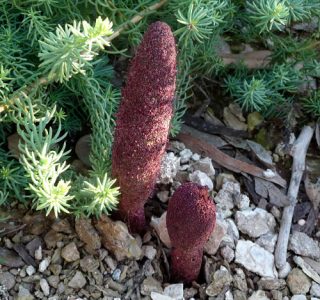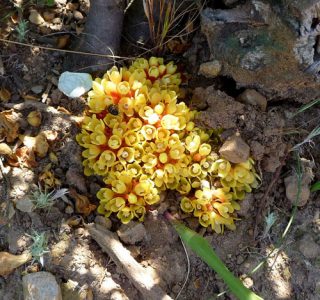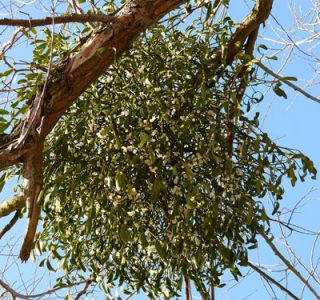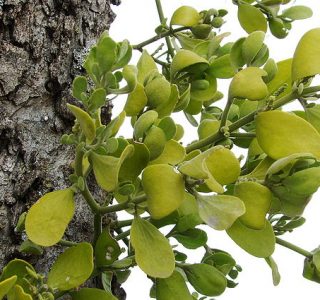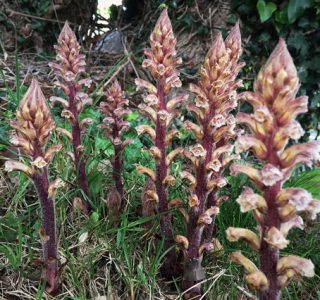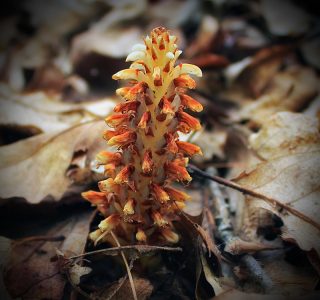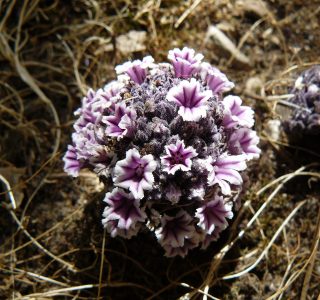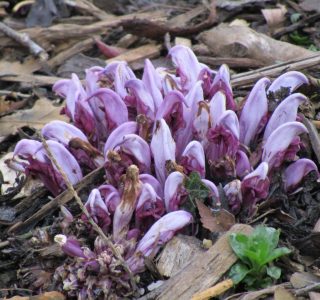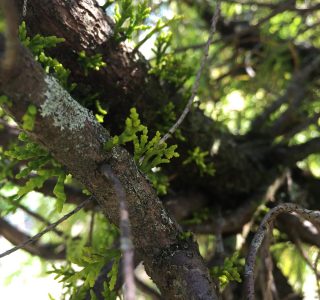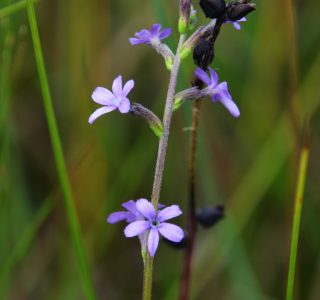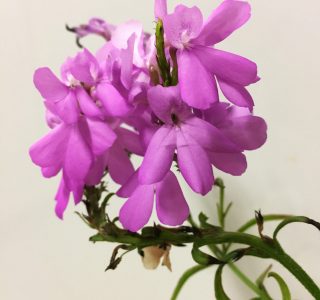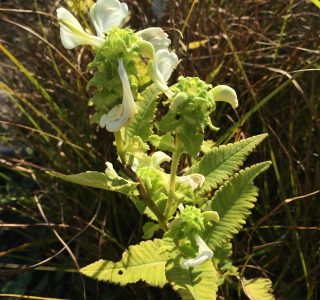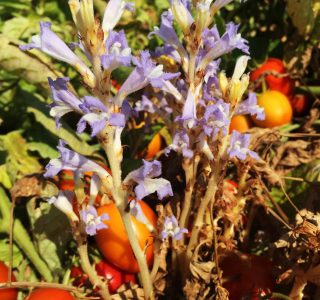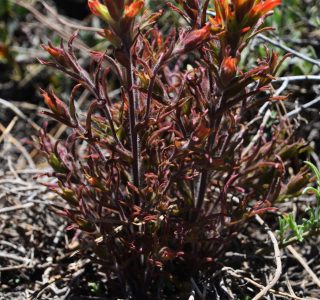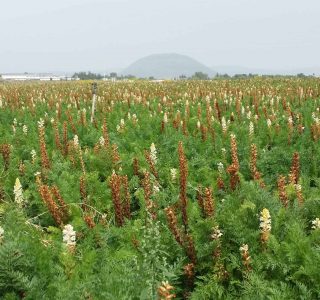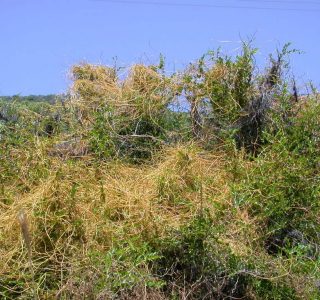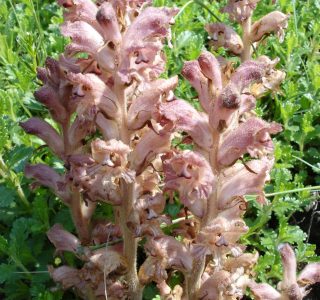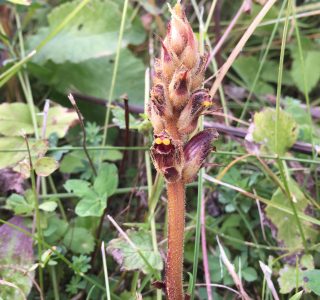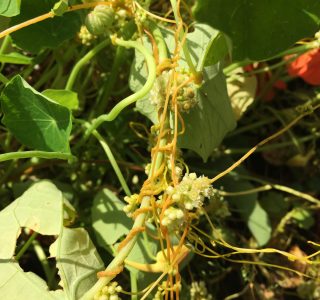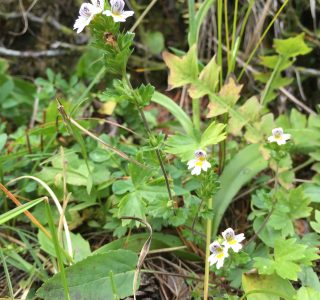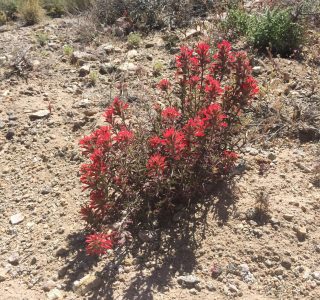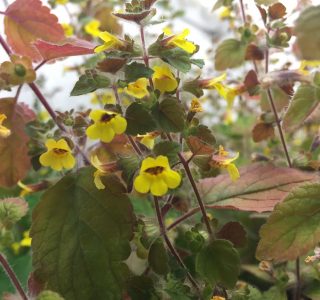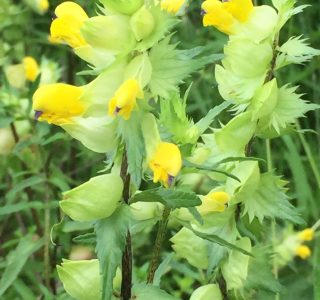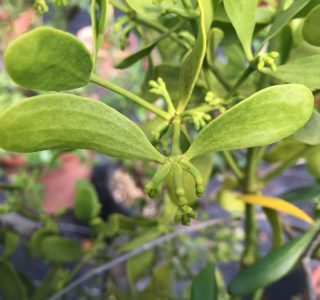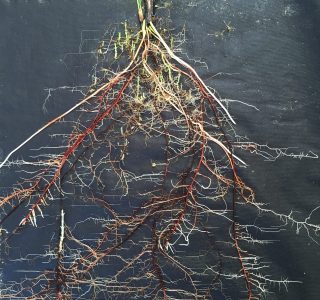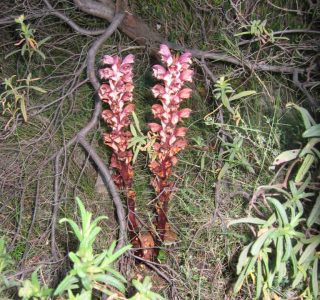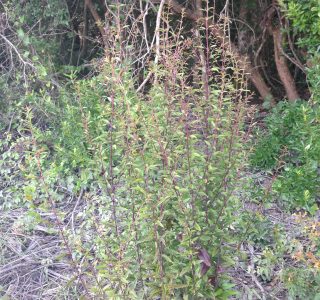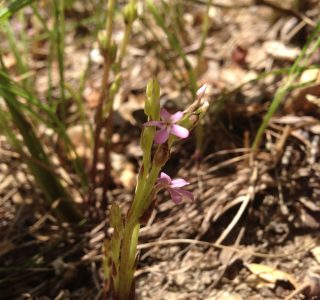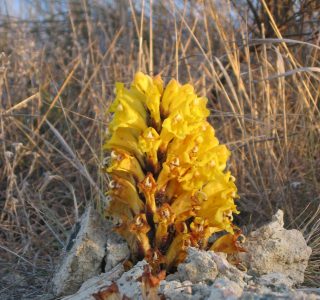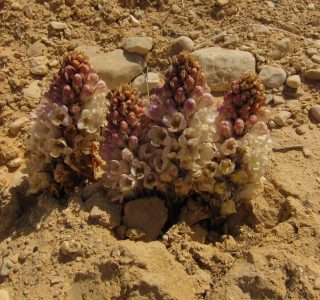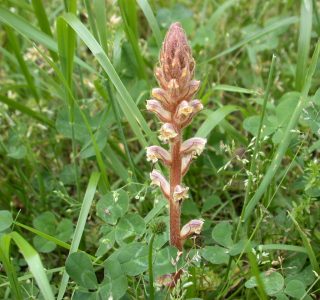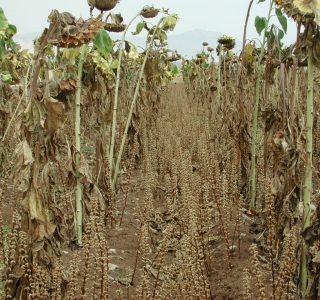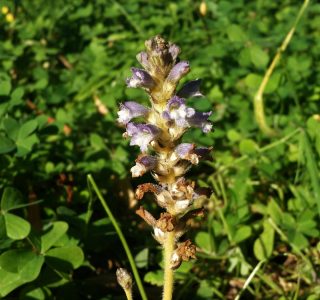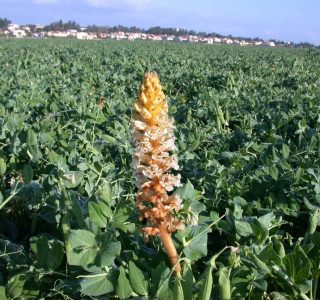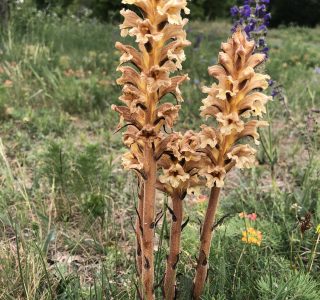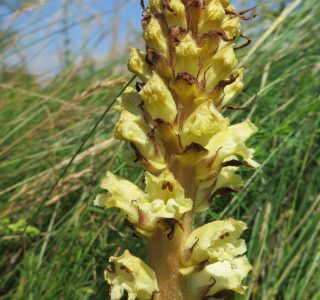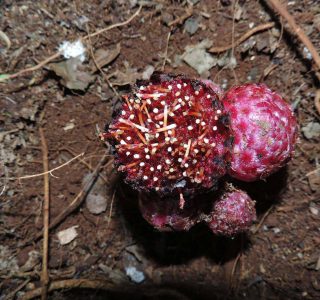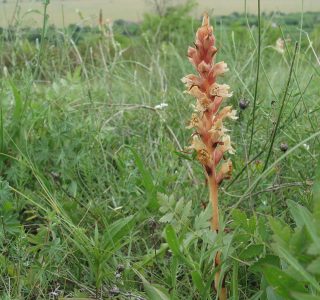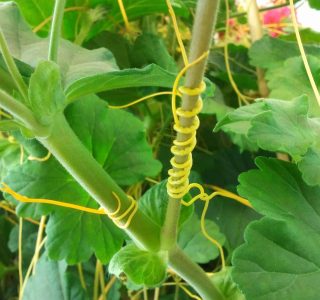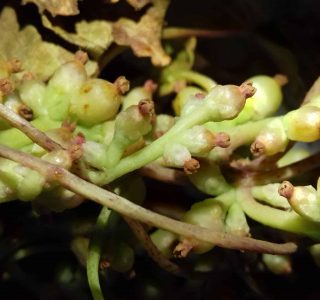
International Parasitic Plant Society
Welcome to the homepage of the International Parasitic Plant Society (IPPS). The IPPS is dedicated to advancing scientific research on parasitic plants. Our goals include increasing the understanding of these amazing plants, providing a platform for exchange among and beyond the scientific community as well as helping to decrease the crop damage inflicted by weedy parasitic plants.
Latest News
- 4th International Congress on Strigolactones (ICS2026) Paris
- Update: 18th World Congress on Parasitic Plants – São Sebastião, Brazil (new dates and venue)
- Our online survey on parasitic weeds in Europe is soon closing
- December IPPS Seminars by Natalia Pabón Mora, Huiting Zhang and Ahmed Choukri
- Rain brings surprising shifts for desert mistletoes and their animal visitors
- First National Symposium on Parasitic Plants Successfully Concluded in Kunming, China
Upcoming: The 18th World Congress On Parasitic Plants (WCPP): 31 May - 5 June 2026 São Sebastião, Brazil.
For more information see Society news.
Member benefits
Discount
Get a member discount for our biennial congress
Meet
Entry in and access to the member’s directory
Inform & get informed
Have access to IPPS seminars; post news on parasitic plants
Meet our talent
Post vacancies for jobs in parasitic plant research
A picture tells
Non-commercial usage rights of the photo gallery
Most recent ‘Parasitic Plant’ publications
on the Web
GC–MS and FTIR characterization, unveiling phenolic content, antioxidant and antibacterial properties of the parasitic plant Cistanche violacea
1 day ago - This study provides a comprehensive investigation to identify the phylogenetic classification of Cistanche violacea using internal transcribed spacer sequencing. Bioactive … more..
Evaluating the optimal level of cowpea grain-wheat bran mixture supplement for Ethiopian Sekota sheep on feed intake, digestibility, body weight change and …
2 days ago - … Striga hermonthica by stimulating the germination of striga seed, but the germinated seedling of striga … its growth, and consequently, the striga seedling will starve to death (… more..
Analisis Risiko Paparan Karbon Monoksida (CO) Terhadap Masyarakat Sekitar Pedagang Sate Menggunakan Metode ARKL Di Kota Parepare
2 days ago - Karbon monoksida (CO) merupakan salah satu polutan udara berbahaya hasil pembakaran tidak sempurna, terutama pada proses pembakaran arang yang digunakan … more..
KAIN BESUREK: WARISAN BUDAYA BENGKULU YANG SARAT MAKNA ISLAM DAN ESTETIKA
2 days ago - … , kemudian divariasikan dengan adanya corak fauna dan flora yaitu bunga Rafflesia. Selain bunga Rafflesia juga ada pula corak burung kuau yang dipadukan dengan … more..
The effects of rapid mitochondrial gene loss on organellar proteomes
2 days ago - … We also compared to the organellar PheRS from 256 another parasitic plant (Balanophora fungosa) that has lost the mitochondrial tRNA-Phe gene. The B. fungosa … more..
Therapeutic Communication Practices in the Drug Rehabilitation Program at Tampan Psychiatric Hospital
2 days ago - The increasing abuse of drugs in Indonesia, including in Riau Province, emphasizes the importance of rehabilitation programs that rely not only on medical intervention … more..
Optimization of the Communication Strategy of Tampan Psychiatric Hospital in Achieving Integrated Health Services
2 days ago - The provision of integrated health services is an important requirement in improving access, quality, and public perception of health service institutions, including the … more..
Most recent 'Parasitic Plant' publications
in Scopus
Corrigendum to "Semen Cuscutae-Fructus Lycii improves spermatogenic dysfunction by repairing the blood-testis barrier in rats according to in silico and in vitro methods" [J Ethnopharmacol. 274 (2021) 114022
Yutian Zhu, Lei Dong, Jingshang Wang, Qiuning Liu, Hongxuan Tong, Yanfeng Li, Siqi Guan
Journal of Ethnopharmacology, volume 355, pages 120189
Thursday 27 November 2025
dc:description
Antidiabetic and Antihyperlipidemic Effects of Hydroalcoholic Extract of Cuscuta reflexa on High-fat Diet and Streptozotocin-Induced Type 2 Diabetic Rats
Saroj Singhmura, Alindam Ghosh, Parthasarathi Panda, Souvik Basak, Nilanjan Ghosh
Natural Products Journal, volume 16
Wednesday 26 November 2025
Aims: Cuscuta reflexa Roxb. has been traditionally utilized as an ethnomedicinal agent for managing various ailments, including diabetes, jaundice, and rheumatic issues. This investigation aimed to evaluate the oral hypoglycemic and hypolipidemic effects of the hydroalcoholic extract of the aerial parts of Cuscuta reflexa (HAECR) in rats with diabe...
Aims: Cuscuta reflexa Roxb. has been traditionally utilized as an ethnomedicinal agent for managing various ailments, including diabetes, jaundice, and rheumatic issues. This investigation aimed to evaluate the oral hypoglycemic and hypolipidemic effects of the hydroalcoholic extract of the aerial parts of Cuscuta reflexa (HAECR) in rats with diabetes induced by a high-fat diet (HFD) and streptozotocin (STZ). Additionally, the study sought to identify the bioactive compounds responsible for these effects in Cuscuta reflexa. Background: To date, only a few attempts have been made to isolate the lead bioactive compound from Cuscuta reflexa, highlighting the need for further exploration of this herb through bioactivity-guided fractionation. The isolation and characterization of the responsible lead molecules could pave the way for developing a new, safer therapeutic option compared to conventionally used drugs. Objectives: The study aims to evaluate the oral hypoglycemic and hypolipidemic activity of hydroalcoholic extract of the aerial parts of Cuscuta reflexa (HAECR) in a high-fat diet (HFD) and streptozotocin (STZ) induced diabetic rats, along with elucidating the responsible bioactive compounds of Cuscuta reflexa. Methods: The hydroalcoholic plant extract was standardized by marker calibration by HPLC and, subsequently, phytochemical screening by LC-MS. Column chromatography was adopted to isolate bioactive compounds from the extract, which NMR, FT-IR, and MS spectroscopy subsequently characterized. Oral antihyperglycemic activity and toxicity studies were performed, and antioxidant activities were studied. Results: No deaths or behavioural changes were observed during the toxicity study up to 2000 mg/kg oral dosing. Other toxicological parameters, such as deviations in organ weights, and haematological, and histological parameters, were also not observed. 250 mg/kg dose of HAECR exhibited significant antihyperglycemic activity (56.9% reduction in blood glucose level) in diabetic rats. In the HAECR-treated groups, significant reductions were observed compared to the control group, with cholesterol levels decreasing by 57%, triglycerides by 50%, SGPT by 50%, and SGOT by 30%. Considering the extensive analytical spectroscopy interpretation results, Quercetin and Stigmasterol are the two possible isolated compounds from our extract. Conclusion: Thus, this study suggested the antihyperlipidemic and antihyperglycemic activity of HAECR, which may be attributed to phytomolecules such as Stigmasterol and Quercetin. Therefore, our findings from the investigated part of the herb could be regarded as an adjunctive agent for treating diabetes mellitus.
Network pharmacological analysis and experimental verification of semen cuscutae in treating postmenopausal osteoporosis
Sheng Xu, Wen Wen Zhang, Wei Wei Zhang, Hong Tao Wang, Jun Zhang, Rui Sheng Yang, Yuan Yuan, Li Wang, Hai Hu Hao
Chinese Journal of Tissue Engineering Research, volume 30, pages 2702-2711
Wednesday 26 November 2025
BACKGROUND: Semen cuscutae, a traditional Chinese medicine, has gradually shown its potential in anti-postmenopausal osteoporosis because of its relatively small side effects, which provides new ideas and possibilities for the treatment of this disease. OBJECTIVE: To explore the mechanism of anti-postmenopausal osteoporosis of semen cuscutae based ...
BACKGROUND: Semen cuscutae, a traditional Chinese medicine, has gradually shown its potential in anti-postmenopausal osteoporosis because of its relatively small side effects, which provides new ideas and possibilities for the treatment of this disease. OBJECTIVE: To explore the mechanism of anti-postmenopausal osteoporosis of semen cuscutae based on network pharmacological analysis and molecular docking and to validate it with animal experiments. METHODS: The main active components and corresponding targets of semen cuscutae were screened in TCMSP database, and the disease targets of postmenopausal osteoporosis were collected in GeneCards, OMIM and PharmGKB databases. After identification of common targets, a series of analyses were carried out, and core targets were selected. The core targets were analyzed by GO function and their role was verified by molecular docking. The corresponding active components were selected for animal experiments. RESULTS AND CONCLUSION: (1) Eleven main active components of semen cuscutae and 110 common targets of semen cuscutae and postmenopausal osteoporosis were screened out, and 10 core targets were identified. (2) GO function analysis showed that the core targets were closely related to oxidative stress and estrogen. (3) The top two ranked core target proteins, interleukin-6 and activated T-cell nuclear factor 1, were molecularly docked, and the top two ranked affinities, picloram and interleukin-6 as well as picloram and activated T-cell nuclear factor 1, were selected for validation in animal experiments. (4) Animal experimental results showed that matrine could inhibit the levels of interleukin-6 and activated T-cell nuclear factor 1 and improve trabecular bone structure of rats with postmenopausal osteoporosis. To conclude, low-dose matrine may affect the steady state of interleukin-6/soluble interleukin-6 receptor system by decreasing the level of interleukin-6, and inhibit the expression of nuclear factor 1 in downstream transcription factor-activated T cells in combination with nuclear factor-κB and mitogen-activated protein kinase signaling pathway to inhibit osteoclast differentiation, reduce bone resorption, repair trabecular structure and treat postmenopausal osteoporosis.
Endemic plant parasite (Cuscuta howelliana) and host (Eryngium castrense) vary along a hydroperiod gradient in California vernal pools
Tirzah Cochran, Madeline Baker, Jamie M. Kneitel
Flora Morphology Distribution Functional Ecology of Plants, volume 334
Tuesday 25 November 2025
Understanding host-parasite interactions is a central question in ecology. The distribution and abundance of plant hosts and parasites tend to be less studied in natural ecosystems. In California, vernal pools are seasonal wetlands that are habitat to the plant parasite Cuscuta howelliana (Bogg's lake dodder) and its most common host, Eryngium cast...
Understanding host-parasite interactions is a central question in ecology. The distribution and abundance of plant hosts and parasites tend to be less studied in natural ecosystems. In California, vernal pools are seasonal wetlands that are habitat to the plant parasite Cuscuta howelliana (Bogg's lake dodder) and its most common host, Eryngium castrense (Coyote thistle). Previous research has identified the interaction and its community effects, but little research has been conducted on their distribution, abundance, and infection patterns, as well as how these change, along a hydroperiod gradient. Ten vernal pools were sampled using 5 random quadrats along 2 transects. Both Cuscuta and Eryngium displayed clumped dispersion patterns within pools. Cuscuta cover had a strong positive association with inundation period and Eryngium traits (height and inflorescence number) had a strong positive association with inundation period. Eryngium plants were smaller at higher densities. Eryngium characteristics were significantly smaller in the presence of Cuscuta infection but highly variable across pools. Path analysis showed that there were significant direct and indirect pathways from hydroperiod to infection rates. The strongest pathway was the increased hydroperiod to increasing Cuscuta cover to increasing infection. These results highlighted the complex interactions among parasite, host, and the environment. This will help understand the spatial ecology of parasite-host interactions along an environmental gradient of this imperiled and diverse ecosystem.
Marula understorey plant species diversity varies among communal rangelands with limited response to mistletoe infection intensity
Tsitsi Sithandiwe Maponga, Dave I. Thompson, Hilton Garikai Taambuka Ndagurwa, Justice Muvengwi, Wayne Twine, Ed T.F. Witkowski
South African Journal of Botany, volume 187, pages 489-510
Tuesday 25 November 2025
Communal rangelands are losing biodiversity and ecosystem function due to land clearing, deforestation, and climate change. However, mistletoes can enhance plant communities by increasing litterfall, soil moisture, and soil fertility. This study examined the effects of mistletoe infection (uninfected, low, and high) on Sclerocarya birrea subsp. caf...
Communal rangelands are losing biodiversity and ecosystem function due to land clearing, deforestation, and climate change. However, mistletoes can enhance plant communities by increasing litterfall, soil moisture, and soil fertility. This study examined the effects of mistletoe infection (uninfected, low, and high) on Sclerocarya birrea subsp. caffra understorey plant assemblages, herbaceous biomass, and herbivory across three sites with different rainfall levels (590 mm, 655 mm, and 695 mm). At the broader community scale, species composition varied significantly across sites, but remained similar across mistletoe infection levels. At a fine, species level scale, the mistletoephily index showed species-specific preferences for different infection levels. The intermediate rainfall site had lower total species richness, diversity, and grass diversity than the other sites. Herbaceous biomass was higher in the wetter than the drier site, while forb and tree richness and diversity were greater in the drier site. Mistletoe infection and its interaction with rainfall site significantly influenced grass and forb diversity. Our findings suggest that moisture is limiting, typical of semi-arid savannas, while mistletoe effects are additive. Therefore, rainfall site influences host tree resource acquisition and competition, shaping understorey plant heterogeneity, while mistletoes provide additional facilitative effects that may further enhance communal rangeland resilience.
Efficacy of the herbal product of Cuscuta campestris Yunck. and Polypodium vulgare L. in patients with obsessive-compulsive disorder: A triple-blind clinical trial
Behnaz Bakhshinejad, Abdolreza Sabahi, Tania Dehesh, Zarrin Sarhadynejad, Mehrnaz Mehrabani, Mahdiyeh Khazaneha, Mehrzad Mehrbani, Mitra Mehrabani
Journal of Ethnopharmacology, volume 354
Monday 24 November 2025
Ethnopharmacological relevance: Cuscuta campestris Yunck. and Polypodium vulgare L. are medicinal plants widely used in traditional Persian medicine to treat various mental health conditions, such as Obsessive-compulsive disorder (OCD). Aim of the study: OCD is among the top ten disorders that cause disability and decrease quality of life. Consider...
Ethnopharmacological relevance: Cuscuta campestris Yunck. and Polypodium vulgare L. are medicinal plants widely used in traditional Persian medicine to treat various mental health conditions, such as Obsessive-compulsive disorder (OCD). Aim of the study: OCD is among the top ten disorders that cause disability and decrease quality of life. Considering the lack of a definitive treatment method and the side effects of the existing drugs, the application of complementary medicine in treating this disorder seems reasonable. The current study aimed to investigate the therapeutic impact of a dodder and polypody herbal product (DPHP) in OCD patients. Materials and methods: In this triple-blind clinical trial, 84 individuals with OCD were assigned to two groups of DPHP and placebo receivers at random. While taking fluvoxamine tablets (100 mg twice daily), the first group was prescribed DPHP tablets, and the second group was prescribed placebo tablets twice daily. The intensity of manifestations and the participant's quality of life were evaluated at the beginning of the trial and after four and eight weeks of intervention using the Yale-Brown and WHOQOL-BREF questionnaires, respectively. Results: The severity of OCD symptoms in both groups decreased significantly after four and eight weeks (P-value <0.001). The DPHP group's reduction rate was significantly higher than the placebo group (P-value = 0.043). The quality of life improved significantly in both groups (P-value <0.001). However, the increase in the quality of life in the DPHP group was significantly higher compared to the placebo group (P-value = 0.042). Conclusions: DPHP, taken alongside fluvoxamine, can effectively alleviate the symptoms of OCD and increase the quality of life. Therefore, it could be regarded as a complementary therapeutic alternative to OCD.
Report on the complete organelle genomes of Orobanche Filicicola Nakai ex Hyun, Y. S. Lim & H. C. Shin (Orobanchaceae): insights from comparison with Orobanchaceae plant genomes
Sang Chul Kim, Eun Su Kang, Tae Hee Kim, Ye Rim Choi, Hyuk Jin Kim
BMC Genomics, volume 26
Sunday 23 November 2025
Background: Orobanche is a parasitic plant distributed in the temperate zone of Northern Hemisphere, with approximately 200 species found worldwide. In the Republic of Korea, two species of Orobanche, namely O. coerulescens Stephan ex Willd. and O. filicicola Nakai ex Hyun, Y. S. Lim & H. C. Shin, are present, with O. filicicola being endemic. Geno...
Background: Orobanche is a parasitic plant distributed in the temperate zone of Northern Hemisphere, with approximately 200 species found worldwide. In the Republic of Korea, two species of Orobanche, namely O. coerulescens Stephan ex Willd. and O. filicicola Nakai ex Hyun, Y. S. Lim & H. C. Shin, are present, with O. filicicola being endemic. Genome analysis of this species has not yet been performed, and characterizing its complete organelle genome will provide valuable insights into the phylogeny and genome evolution of parasitic plants. Results: The chloroplast and mitochondrial genomes were analyzed, revealing distinct characteristics. The chloroplast genome is 91,529 bp long with a GC content of 33.6%, containing 33 protein-coding, 30 tRNA, and 4 rRNA genes. In contrast, the mitochondrial genome is 1,058,991 bp long with a GC content of 45.5%, featuring 31 protein-coding, 16 tRNA, and 3 rRNA genes. The mitochondrial genome has over three times more simple sequence repeats and longer long repeats than the chloroplast genome. Analysis of synonymous codon usage in protein-coding genes from nine Orobanchaceae species revealed significant differences between chloroplasts and mitochondria, with codons ending in A or T exhibiting higher coding rates. Ka/Ks ratio calculations indicated that psbI and atpB had the smallest and largest ratios in chloroplasts, respectively, while ccmFC was identified as the only gene under positive selection in mitochondria genomes. Sequence alignment identified 30 homologous fragments between the two genomes, totaling 7,247 bp. Comparison of O. filicicola’s chloroplast genome with related species showed gene loss and conserved inverted repeat sequences. Numerous homologous collinear blocks were found in mitochondrial genomes of related species, but some regions lacked homology. Phylogenetic analysis indicated identical topologies for chloroplasts and mitochondria, with Orobanchaceae forming a strong monophyletic group. Conclusions: Characterizing the complete organelle genome of O. filicicola enabled a comprehensive analysis of the Orobanchaceae organelle genome, providing important baseline data for its structure and evolution.
Orobanche aegyptiaca-chitosan nanocomposite efficacy against the freshwater snail Biomphalaria alexandrina
Reda Ramadan Abdel-Khalek, Fathy Abdel-Ghaffar, Salwa Abdel Hamid Hamdi, Amina M. Ibrahim, Mona Fathi Fol, Nesma Abbas Mostafa
Scientific Reports, volume 15
Sunday 23 November 2025
As one of the neglected tropical diseases, schistosomiasis is responsible for various social and economic issues in numerous developing countries. The intermediate host of Schistosoma mansoni is the Biomphalaria alexandrina snails. A promising approach to mitigate the transmission of this disease is to use medicinal plants loaded with nanomaterials...
As one of the neglected tropical diseases, schistosomiasis is responsible for various social and economic issues in numerous developing countries. The intermediate host of Schistosoma mansoni is the Biomphalaria alexandrina snails. A promising approach to mitigate the transmission of this disease is to use medicinal plants loaded with nanomaterials to control these snails. This research aimed to investigate the molluscicidal activity of Orobanche aegyptiaca- chitosan nanocomposite on B. alexandrina snails. The phytochemical screening of the tested plant verified its abundance of saponins, tannins, and flavonoids, which may be responsible for its cytotoxic effects. Chitosan nanoparticles were produced using the ionotropic gelation technique, while the O. aegyptiaca-chitosan nanocomposite was synthesized using the sonochemical approach. The characterization of the nanocomposite was carried out using TEM, XRD, and Zeta potential. The results demonstrated that the survival, fecundity (eggs/snail/week), and reproductive rates of B. alexandrina snails were substantially reduced upon exposure to the sub-lethal concentrations LC10 or LC25 of O. aegyptiaca-chitosan nanocomposite. Biochemically, it adversely affected some parameters, where it considerably (P < 0.05) raised ALT, AST, and ALP levels, while urea, uric acid, and cholesterol were significantly decreased compared to control snails. Furthermore, the antioxidant markers CAT, SOD, and GSH exhibited a substantial (P < 0.05) reduction, while MDA and NO levels increased at both sublethal concentrations. Histopathological examinations of the digestive gland of the treated B. alexandrina revealed a decrease in the size of the tubules, and the digestive and secretory cells degenerated. The hermaphrodite glands exhibited substantial damage in the reproductive tubules, with extensive damage to the gonadal cells, resulting in the loss of ova and sperm shapes. Also, the comet analysis showed a genotoxic effect of the nanocomposite, evidenced by significant changes in crucial comet assay parameters: tail length (TL), tail DNA percentage (TD), tail moment (TM), and olive tail moment (OTM). Conclusively, these findings confirmed the potential activity of O. aegyptiaca- chitosan nanocomposite as a molluscicidal agent against B. alexandrina to decrease schistosomiasis transmission.
Parasitic plant Cistanche tubulosa shapes the bacterial community structure and functional composition of the salt-tolerant host Tamarix chinensis across different parasitic statuses
Luyao Tang, Xiaoshan Liu, Shuhong Lin, Le Zhan, Yehua Chen, Yanan Han, Lei Wang, Jinchang Liang, Zhong Zhang
Environmental Microbiome, volume 20
Saturday 22 November 2025
Background: Root-associated microbiomes are crucial for assisting host and parasitic plants cope with environmental stress. However, little research exists on bacterial community characteristics of parasites and hosts under different parasitic statuses. In this study, we used Cistanche tubulosa and Tamarix chinensis as parasitic and host plant mode...
Background: Root-associated microbiomes are crucial for assisting host and parasitic plants cope with environmental stress. However, little research exists on bacterial community characteristics of parasites and hosts under different parasitic statuses. In this study, we used Cistanche tubulosa and Tamarix chinensis as parasitic and host plant models, respectively, and aimed to determine the assembly mechanisms and role in assisting plants in salt stress tolerance of root-associated bacterial communities. Results: The different parasitic statuses are closely related to the variations in bacterial communication and community assembly mechanisms between the host and parasitic plants. The percentages of potential microbiota sourced from the parasite to the host (44.83% and 83.50%) were greater than those from the host to the parasite (17.50% and 54.67%) in the re-parasitism and flowering stages, illustrating that parasites play a dominant role in shaping the host root microbiota. In addition, the host has a more complex and robust root microbiota co-occurrence network than the parasite does, whereas the KEGG results revealed that the predicted bacterial communities of the parasite-associated microbiota contain more genes in plant growth promotion, salt‒alkali stress resistance, and substance metabolism. Moreover, the salinity, NH<inf>4</inf><sup>+</sup>, and total potassium were significantly correlated with the bacterial community distributions of the two plants. Conclusion: Our results indicate that parasitic status significantly affects the distribution of root bacterial communities, bacterial transfer, and material metabolism of the two plants at different parasitic statuses, reflecting the adaptive mechanisms of plants and bacteria under parasitic relationships and providing ideas for the utilization of saline-alkaline land.
Galactosylated liposomes for targeted encapsulation and enhanced cytotoxicity of Mistletoe Lectin, an antitumoral type 2 ribosome-inactivating protein
Josanna Kaufmann, Eray Cetin, Tiana Kraus, Harden Rieger, Gero Leneweit
International Journal of Pharmaceutics X, volume 10
Saturday 22 November 2025
The development of efficient liposomal encapsulations of proteins for pharmaceutical applications is limited by several factors: their high molecular weight, interactions with surrounding substances, or the generally lower stability compared to small molecules. In this work, various liposomal formulations were prepared using the thin-film hydration...
The development of efficient liposomal encapsulations of proteins for pharmaceutical applications is limited by several factors: their high molecular weight, interactions with surrounding substances, or the generally lower stability compared to small molecules. In this work, various liposomal formulations were prepared using the thin-film hydration method followed by extrusion, to investigate their suitability for the encapsulation of the plant-derived antitumoral mistletoe lectin-1 (ML-1). This can be significantly optimized by exploiting its preferential binding to galactose-containing structures, such as modified lipids integrated into the liposomal bilayer. Incorporation of the galactosylated lipid DSPE-PEG2k-Gal into the membrane significantly enhanced the overall recovery rate and encapsulation efficiency of ML-1, attributed to its affinity for the functionalized component. Compared to non-functionalized liposomes, a 2-fold to 4-fold increase in percentage encapsulation efficiency was observed. The galactosylated lipid optimized the ratio of encapsulated to surface-adsorbed ML-1 and facilitated its preferential localization within the core of the liposomes. A strong correlation was identified between the number of entrapped ML-1 molecules per liposome and the degree of galactosylation. The formulations demonstrated high in vitro cytotoxicity, as exemplified with murine colon-26 carcinoma cells, with the galactose-functionalized liposomes achieving an IC<inf>50</inf> value comparable to free ML-1. This strategy presents significant potential for developing more efficient and targeted liposomal formulations of pharmaceutical proteins with specific affinities to tailored lipid components, advancing drug delivery technologies, and improving therapeutic options for cancer treatment.
Differential effects of precipitation pulses on two mistletoe species and their associated fauna in a semi-arid environment
Valentina Vilches-Gómez, José I. Orellana, Francisco E. Fontúrbel
Journal of Arid Environments, volume 232
Friday 21 November 2025
Semi-arid ecosystems are highly limited by water availability; thus, precipitation pulses can generate significant impacts on plant populations. We evaluated the effects of rainfall pulses on the phenologies of two mistletoe species (Tristerix aphyllus and T. verticillatus) and their associated fauna in Las Chinchillas National Reserve, Chile. Base...
Semi-arid ecosystems are highly limited by water availability; thus, precipitation pulses can generate significant impacts on plant populations. We evaluated the effects of rainfall pulses on the phenologies of two mistletoe species (Tristerix aphyllus and T. verticillatus) and their associated fauna in Las Chinchillas National Reserve, Chile. Based on a two-year camera trap survey (2021–2023), we recorded a total of 21,083 visits. Although 2022 began following a 2021 hydric deficit, a large rainfall pulse during the austral winter altered conditions, influencing the patterns observed in 2023. Tristerix aphyllus (a holoparasite specialized on cacti) showed a decrease in flowering after the rainfall pulse, whereas T. verticillatus (a generalist hemiparasite) showed an increase in flowering and fruiting. Associated fauna showed a significant variation between years: both species experienced greater visitor abundance after the pulse, but only T. verticillatus showed increased species richness (from 3.71 to 7.30 species in average). Beta diversity values indicated greater species turnover in T. aphyllus (57.14 %) than in T. verticillatus (17.39 %); small mammals became more dominant than birds after the rainfall pulse. These results show differential effects of rainfall pulses between mistletoe species, shedding light on the complex ecological dynamics underlying Mediterranean semi-arid environments.
Molecular and agronomic assessment of faba bean genotypes identifies resistance to Orobanche crenata infestation
Yu Wang, Yossry E. Salama, Khaled E. Amer, Waly F. Elsayed, Salwa A. Orabi, Ahmed H. El-Sappah, Ehab M.B. Mahdy, Ehab M. Zayed, Mohamed M.A. Elashtokhy
Scientific Reports, volume 15
Friday 21 November 2025
Faba bean (Vicia faba L.)(V. faba), an essential legume in Egypt, is severely impacted by broomrape (Orobanche crenata) (O. crenata), a parasitic weed that feeds on roots, making chemical control difficult without harming the crop. Three faba bean genotypes (Giza-843, Misr-3, and Sakha-3) along with nine pure lines were evaluated for resistance t...
Faba bean (Vicia faba L.)(V. faba), an essential legume in Egypt, is severely impacted by broomrape (Orobanche crenata) (O. crenata), a parasitic weed that feeds on roots, making chemical control difficult without harming the crop. Three faba bean genotypes (Giza-843, Misr-3, and Sakha-3) along with nine pure lines were evaluated for resistance to broomrape in field trials (2021–2023) using gene barcoding (rbcL, rpoC1), ten Start Codon Targeted (SCoT) markers, and phonological and agronomic traits to identify resistance sources. Five faba bean genotypes—Giza 843, Lines 2, 7, 8, and 9—significantly reduced all broomrape growth and productivity traits. Line 5 had the lowest spike length, fresh and dry spike weight, number of spikes/m<sup>2</sup>, and number of capsules/spike across both seasons. Genotypes Line 5, Line 6, and Misr 3 exhibited the highest seed yield per plot and hectare under normal and broomrape-infested conditions. Line 4 showed the lowest yield reductions, followed by Lines 9 and 8. The study generated 103 amplicons with a polymorphism rate of 51.46%, with SCoT-10 being the most informative marker, revealing 69% polymorphism and affecting 13 amplicons. Three faba bean genotypes showed significant genetic diversity, high seed output, and effectively reduced broomrape growth, highlighting their potential for genetic improvement and sustainable use in future research. Four faba bean genotypes, namely Sakha 3, Line 2, Line 4, and Line 9, are promising genotypes for combating broomrape infestation.
Predicting parasitic plants Loranthus Europaeus range shifts in response to climate change
Marlena Baranowska, Adrian Łukowski, Robert Korzeniewicz, Wojciech Kowalkowski, Łukasz Dylewski
Scientific Reports, volume 15
Thursday 20 November 2025
Climate change significantly influences the distribution of parasitic species, posing threats to ecosystems and economies. This study examines the potential range expansion of Loranthus europaeus, a parasitic plant impacting European forestry. We assessed the impact of predicted climate change for 2041–2060 and 2061–2080 using MaxEnt modeling b...
Climate change significantly influences the distribution of parasitic species, posing threats to ecosystems and economies. This study examines the potential range expansion of Loranthus europaeus, a parasitic plant impacting European forestry. We assessed the impact of predicted climate change for 2041–2060 and 2061–2080 using MaxEnt modeling based on current occurrence data of L. europaeus, and the main host plant genus oak Quercus, as well as bioclimatic variables. Our model demonstrated high predictive accuracy (AUC = 0.92). The most important variables for Europe range were range of Quercus genus. Key environmental factors included isothermality (bio3) and mean temperature of wettest quarter (bio8). Under SSP126 and SSP245 scenarios, our results predict significant range expansions into northern and eastern Europe, with increases of 43.5% and 53.9% by 2041–2060. Conversely, southern Europe may see contractions of 16.4–20.6%. Projections for 2061–2080 indicate further expansions up to 65.8% in northern Europe, alongside contractions up to 29.8% in southern regions, including Turkey and Greece.These shifts highlight the influence of climate change on L. europaeus distribution and underscore the need for adaptive management strategies to mitigate potential ecological and economic impacts.
Inoculation with Talaromyces trachyspermus and arbuscular mycorrhizal fungus alongside sulfonylurea herbicides alters Orobanche aegyptiaca and tomato growth
Mina Agha Baba Dastjerdi, Ali Reza Yousefi, Khalil Jamshidi, Majid Pouryousef, Setareh Amanifar
Scientific Reports, volume 15
Wednesday 19 November 2025
The life cycle and unique biology of broomrape (Orobanche aegyptiaca) have made the management of this root- parasitic plant one of the greatest challenges in agriculture. The objective of this investigation was to ascertain whether the efficacy of chemical weed control could be enhanced through the inoculation of tomato plants with mycorrhizal and...
The life cycle and unique biology of broomrape (Orobanche aegyptiaca) have made the management of this root- parasitic plant one of the greatest challenges in agriculture. The objective of this investigation was to ascertain whether the efficacy of chemical weed control could be enhanced through the inoculation of tomato plants with mycorrhizal and Talaromyces trachyspermus fungus. The combined effect of utilizing these fungi with the sulfonylurea herbicides (rimsulfuron and sulfosulfuron) with two application methods (herbigation and foliar spraying) was investigated in greenhouse and field trials. The results showed the application of rimsulfuron and sulfosulfuron, respectively, resulted in a 99.5% and 99.9% reduction in production capacity in the presence of the mycorrhizal fungus, as evidenced in the greenhouse experiment. The application of rimsulfuron using the herbigation method resulted in a 50% reduction in seed production in the presence of mycorrhiza in the field experiment. The application of the mycorrhizal fungus resulted in a reduction of the number of broomrape shoots by 17.2% with rimsulfuron and 62.1% with sulfosulfuron in the foliar spraying method in the greenhouse experiment. In the presence of mycorrhizal fungus, sulfosulfuron in the herbigation method demonstrated a 37.8% reduction in the number of broomrape shoots compared to the absence of herbicide in the field experiment. The highest marketable yield of tomato was observed in the mycorrhizal plants, where rimsulfuron was applied in the field experiment. The findings highlight the potential of integrated biological-chemical strategies as a sustainable and environmentally friendly alternative for the management of this parasite weed. Moreover, they demonstrate the feasibility and potential of such strategies to facilitate the resolution of this pivotal challenge in agricultural practice.
Impact of pollution on microbiological dynamics in the pistil stigmas of Orobanche lutea flowers (Orobanchaceae)
Karolina Wiśniewska, Sebastian Wojciech Przemieniecki, Krzysztof Krawczyk, Anna Hoffmann, Renata Piwowarczyk
Scientific Reports, volume 15
Tuesday 18 November 2025
Our understanding of the basic relationships of microbiota associated with flowers is still quite limited, especially regarding parasitic plant species. The transient nature of flower parts such as pistil stigmas provides a unique opportunity for temporal investigations. This is the first report of the analysis of bacterial and fungal communities a...
Our understanding of the basic relationships of microbiota associated with flowers is still quite limited, especially regarding parasitic plant species. The transient nature of flower parts such as pistil stigmas provides a unique opportunity for temporal investigations. This is the first report of the analysis of bacterial and fungal communities associated with the pistil stigmas of the lucerne parasite, Orobanche lutea. We compared the microorganism communities at different developmental stages and assessed the impact of pollution at the sampling sites. We also examined the plant growth properties (PGP) of bacteria in a culture-dependent analysis. The predominant colonizers of the pistil stigmas were Proteobacteria (99.25%), with Enterobacteriaceae (49.88%) and Pseudomonadaceae (48.28%) being the major families. The prevalent fungal phylum was Basidiomycota (71.64%), with Filobasidiales (33.14%) and Tremellales (27.27%) as dominant orders. Microbial populations in polluted area showed increased bacterial and fungal diversity. Mature stigmas exhibited greater microbial variety compared to immature ones. We found higher fungal than bacteria abundance at both polluted and unpolluted sites. In culture-dependent analysis, immature stigmas from unpolluted area had the least bacterial morphotypes. Identified culturable bacteria represented the Acinetobacter, Erwinia, Micrococcus, Oceanobacillus, Pantoea, Pseudomonas, Serratia, and Staphylococcus genera. The assessment of PGP traits revealed multiple strains with plant growth-promoting potential. Microbial composition varied between polluted and unpolluted sites and was influenced by the flower’s developmental stage.
© Copyright IPPS 2010-2025 • Disclaimer • Privacy • Terms and conditions • Contact


